
A gin and tonic is a highball cocktail made with gin and tonic water poured over a large amount of ice. The ratio of gin to tonic varies according to taste, strength of the gin, other drink mixers being added, etc., with most recipes calling for a ratio between 1:1 and 1:3. It is usually garnished with a slice or wedge of lime. To preserve effervescence, the tonic can be poured down a bar spoon. The ice cools the gin, dulling the effect of the alcohol in the mouth and making the drink more pleasant and refreshing to taste.
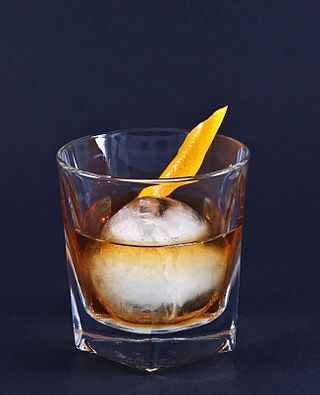
The old fashioned is a cocktail made by muddling sugar with bitters and water, adding whiskey, and garnishing with an orange slice or zest and a cocktail cherry. It is traditionally served with ice in an old fashioned glass.
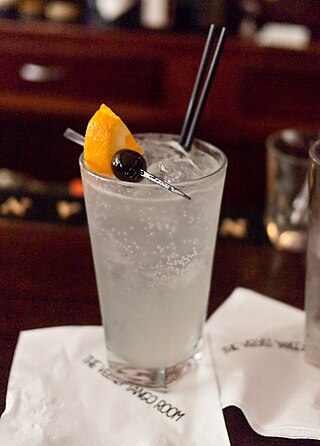
The Tom Collins is a Collins cocktail made from gin, lemon juice, sugar, and carbonated water. First memorialized in writing in 1876 by Jerry Thomas, "the father of American mixology", this "gin and sparkling lemonade" drink is typically served in a Collins glass over ice. A non-alcoholic "Collins mix" mixer is produced, enjoyed by some as a soft drink.
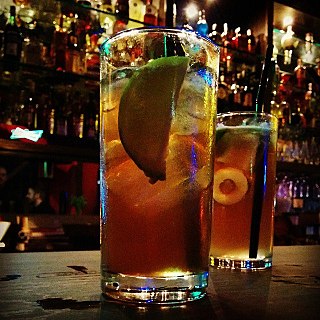
The Long Island iced tea, or Long Island ice tea, is an IBA official cocktail, typically made with vodka, tequila, light rum, triple sec, gin, and a splash of cola. Despite its name, the cocktail does not typically contain iced tea, but is named for having the same amber hue as iced tea.

The martini is a cocktail made with gin and vermouth, and garnished with an olive or a lemon twist. Over the years, the martini has become one of the best-known mixed alcoholic beverages. A popular variation, the vodka martini, uses vodka instead of gin for the cocktail's base spirit.
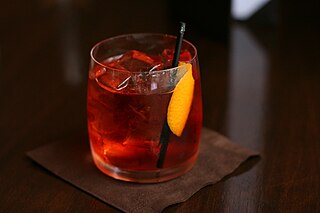
A Negroni is an Italian cocktail, made of one part gin, one part vermouth rosso and one part Campari, garnished with orange peel. It is considered an apéritif.

The hanky panky is a cocktail made from gin, sweet vermouth, and Fernet-Branca. It is a variation on the sweet martini, or Martinez, made distinctive by the Fernet-Branca, a bitter Italian digestivo. It was created by Ada "Coley" Coleman, head bartender at the Savoy Hotel, London.

A sour is a traditional family of mixed drinks. Sours belong to one of the old families of original cocktails and are described by Jerry Thomas in his 1862 book How to Mix Drinks.

"Shaken, not stirred" is how Ian Fleming's fictional British Secret Service agent James Bond prefers his martini cocktail.

Lillet is a French wine–based aperitif from Podensac. Classed as an aromatised wine within EU law, it is a blend of 85% Bordeaux region wines and 15% macerated liqueurs, mostly citrus liqueurs. The mix is then stirred in oak vats until blended. During the aging process, Lillet is handled as a Bordeaux wine.
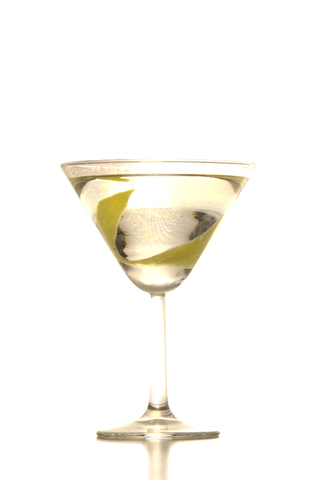
The Vesper is a cocktail that was originally made of gin, vodka, and Kina Lillet. Since that form of Lillet is no longer produced, modern bartenders need to modify the recipe to mimic the original taste.
The 20th century is a cocktail created in 1937 by a British bartender named C.A. Tuck, and named in honor of the celebrated 20th Century Limited train which ran between New York City and Chicago from 1902 until 1967. The recipe was first published in 1937 in the Café Royal Cocktail Book by William J Tarling, President of the United Kingdom Bartenders' Guild and head bartender at the Café Royal.

The Malecon is a cocktail named after the El Malecón, the winding beachfront avenue atop the seawall in Havana, Cuba.

Cocchi Americano is a quinine-flavored aperitif wine produced by Giulio Cocchi Spumanti in the Asti province of Italy. Cocchi Americano is a variety of Americano. The wine was developed by Giulio Cocchi, and production began in 1891. Cocchi also produces a pink variety of this aperitif, the "Cocchi Americano Rosa", which is slightly more bitter and aromatic than the standard white Cocchi Americano.
The corpse reviver family of named cocktails are sometimes drunk as alcoholic hangover tongue-in-cheek "cures", of potency or characteristics to be able to revive even a dead person. Some corpse reviver cocktail recipes have been lost to time, but several variations commonly thought to be tied to the American Bar at the Savoy Hotel remain, especially those espoused by Harry Craddock that originally date back to at least 1930 and are still being made. Many "reviver" variations exist and the word is sometimes used as a generic moniker for any morning-after cocktail, also known as a "hair of the dog".
An aromatised wine is a fortified wine or mistelle that has been flavoured with herbs, spices, fruit or other natural flavourings.
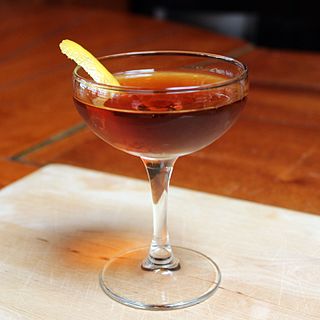
The Martinez is a classic cocktail that is widely regarded as the direct precursor to the Martini. It serves as the basis for many modern cocktails, and several different versions of the original exist. These are generally distinguished by the accompaniment of either Maraschino or Curacao, as well as differences in gin or bitters.














